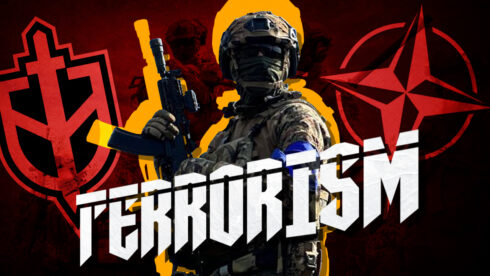Although it should come as no surprise to any student of recent history that the United States will attack Russia via terrorist proxies, the recent cross-border raids into Russia by the Russian Volunteer Corps is a brazen escalation that threatens to transform the regional conflict into a direct war between NATO and the Russian Federation. From Afghanistan during the Cold War, through the Caucasus Republics after the collapse of the USSR, to the present day, the U.S. has a sordid history of leveraging extremist non-state actors to weaken Russia. Poland appears to be a significant ally in helping the United States achieve it aims in Ukraine, from the violent escalation of the Maidan, to supplying boots on the ground in assisting the RVC’s incursions into Russian territory.
During the 1980s the CIA armed and funded the Mujahedeen, the precursor of the Taliban, to combat Soviet interests during its incursion into Afghanistan. This Islamic fundamentalist proxy would later morph into the Taliban, and influence even more sinister extremist groups, some of which the world is still struggling to extinguish. The CIA and its allies in the Gulf would later partner with various Islamic extremist groups in the Caucasus Republics of Chechnya and Dagestan in an effort to pull apart a weakened Russian Federation after the demise of the USSR. A fledgling president Vladimir Putin was able to galvanize Russian society and the armed forces to defeat this threat; however, the FSB and GRU still combat small terrorist group in the Caucasus even today. While aiming to turn Chechnya into a catalyst that would rip the “soft underbelly” of Russia from its newly formed federation, the result was a Chechen Republic that has proven to be a reliable and loyal member of the new union, led by a steadfast Putin ally.
The conflict in Syria that began in 2011 was sown by the CIA and its Gulf state partners once again, largely as an effort to weaken and undercut the Russian majority share of oil and natural gas supply to Europe. This plan backfired spectacularly when Russia took a decisive stand and directly intervened on the behalf of its long-time ally. This has further resulted in a stronger Syria-Iraq-Iran alliance, an increasingly isolated Israel, and a Russia that is an effective power broker and peace maker in the region.
Anyone with even a cursory understanding of the aforementioned history was not surprised by the revelation that the recent cross-border attacks on small Russian border towns in the Bryansk and Belgorod regions by a terrorist organization founded by Russian and Belorussian neo-Nazis was supported by the United States, Ukraine and Poland. Ukraine, Poland and the United States are aiding and abetting a terrorist organization by providing it political legitimacy, funding, training, advanced armaments, and even directly assisting it in conducting its attacks by supplementing its ranks with U.S. and Polish “mercenaries”.
The Russian Federation must call out those nations involved and officially declare them as state sponsors of terrorism. Although likely a futile, but symbolic effort must be made by Russia to highlight this reality at the United Nations. The Russian security and intelligence services must make all efforts to locate the leaders and decision-making apparatus of the RVC (RVD in Russian) and eliminate them regardless of whether or not some are NATO member personnel that are an intrinsic element of the organization. It is most probable that any NATO personnel killed of wounded in any Russian military actions would be disavowed by their governments in the interests of plausible deniability.
The Russian leadership can not allow a terrorist organization to target its territory, assault and murder its citizens, take hostages, and demand the overthrow of its legitimate government. Its sponsors must be labeled accurately in the public sphere and a diplomatic effort must be mounted to amplify Moscow’s position. Not only is this important in meeting the challenges of the current conflict but will be crucial to any legal proceedings following its conclusion.
One positive conclusion that can be garnered from these recent developments, is that Ukraine and its NATO backers are desperate to obfuscate from the recent battlefield defeats of the regime in Kiev and the disastrous initial failure of the much-hyped Spring counteroffensive. The obvious Ukrainian operation to flood the left bank of the Kherson river by partially destroying the Kakhovka dam only supports the theory that the anxiously awaited AFU counteroffensive has so far come to naught, and that Ukraine is hoping to strengthen their defensive position along the Southern Dnieper River and deal a significant hinderance to the Russian military infrastructure and offensive capability in the region. It also buys the AFU time and allows them to concentrate forces in other areas of military effort.
It is becoming more apparent that the regime in Kiev is becoming increasingly desperate to either achieve propaganda victories to urge its NATO backers to continue to escalate the conflict in support of Ukraine, or to try any means available, no matter how illegal and abhorrent, to forestall their inevitable defeat in a war of attrition that they have no chance of winning. What will it take for the overwhelming majority of the world that has largely remained neutral in the conflict to finally denounce the criminal regime in Kiev? How many more innocent people need to die to satiate the whims of a corrupt Western political elite before the silent majority finally decide to speak out in defiance of this savage lunacy? Will it take a nuclear catastrophe to finally give a voice to those with a conscience? It is quite probable that those in the Kremlin understand that the regime in Kiev will continue to escalate these acts of depravity until they reach a point that the entire world will finally see its true nature and will finally support Russia in excising this evil from existence. One shudders to think of the human cost that this will require.



